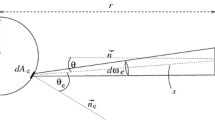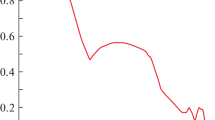Abstract
The processes of radiative heat transfer in a fireball which develops upon ignition of a cloud of hydrocarbon fuel near the Earth’s surface are simulated numerically. The emissive characteristics of combustion products (mixtures of nitrogen dioxide, water vapor, and soot) are described using the weighted-sum-of-gray-gases model with temperature-dependent weighting coefficients. The radiation field in the fireball for individual gray gases is calculated in a diffusion approximation (gases for which the fireball is optically thick) or in a volume emission approximation (gases for which the fireball is optically thin). Results of calculations for propane fireballs with fuel masses of 1 g to 103 kg are presented. The role of scale effects is analyzed by comparing the spatial distributions of the radiative source term for fireballs of different dimensions. It is shown that the radiation of burning clouds of small scale proceeds uniformly over the volume, whereas fireballs of large scale radiate predominantly from the surface. The calculated fraction of energy converting to radiation is in good agreement with literature data. The radiation field outside fireballs and the fluxes on the surface are calculated by the Monte Carlo method. The dose of energy incident on the surface during burning of a fireball is calculated.
Similar content being viewed by others
References
AIChE/CCPS. Guidelines for Evaluating the Characteristics of Vapor Cloud Explosions, Flash Fires, and BLEVEs, Amer. Inst. Chem. Engineers, New York (1994).
R. W. Prugh, “Quantitative evaluation of fireball hazard,”Process Saf. Progr.,13, No. 2, 83–91 (1994).
Mudan, K. S., Croce, P. A., “Fire hazard calculations for large open hydrocarbon fires,” in:SFPE Handbook of Fire Protection Engineering, Nat. Fire Protection Association, Quincy, MA (1995), pp. 3/197–3/240.
G. M. Makhviladze, J. P. Roberts, and S. E. Yakush, “Fireball during combustion of hydrocarbon fuel releases. I. Structure and lift dynamics,”Fiz. Goreniya Vzryva,35, No. 3 (1999), pp. 7–19.
B. F. Magnussen and B. H. Hjertager, “On the mathematical modeling of turbulent combustion with special emphasis on soot formation and combustion,” in:Sixteenth Symp. (Int.) in Combustion, The Combustion Inst., Pittsburgh, PA (1976), pp. 711–729.
P. A. Tesner, T. D. Snegiriova, and V. G. Knorre, “Kinetics of dispersed carbon formation,”Combust. Flame,17, 253–260 (1971).
S. Galant, D. Grouset, G. Martinez, et al., “Three-dimensional steady parabolic calculations of large-scale methane turbulent diffusion flames to predict flare radiation under cross-wind conditions,” in:Twentieth Symp. (Int.) on Combustion, The Combustion Institute, Pittsburgh, PA (1984), pp. 531–540.
R. Viskanta, and M. P. Mengüç, “Radiation heat transfer in combustion systems,”Prog. Energ Combust. Sci.,13, 97–160 (1987).
S. T. Surzhikov, “Four-component numerical simulation model of radiative convective interactions in large-scale oxygen-hydrogen turbulent fireballs,”ASME HTD,335, 401–412 (1996).
S. T. Surzhikov, “Thermal radiation from large-scale oxygen-hydrogen fireballs. Analysis of the problem and main results,”Teplofiz. Vys. Temp.,35, No. 3, 416–423 (1997).
S. T. Surzhikov,Computational Experiment in Developing Radiative Models of the Mechanics of Radiating Gas [in Russian], Nauka, Moscow (1992).
H. C. Hottel and A. F. Sarofim,Radiative Transfer, McGraw-Hill, New York (1967).
M. F. Modest, “The weighted-sum-of-gray-gases model for arbitrary solution methods in radiative transfer,”ASME J., Heat Transfer,113, No. 8, 650–656 (1991).
M. F. Modest,Radiative Heat Transfer, McGraw-Hill, New York (1993).
J. D. Felske and T. T. Charalampopoulos, “Gray gas weighting coefficients for arbitrary gas-soot mixtures,”Int. J. Heat Mass Transfer,25, No. 12, 1849–1855 ( (1982).
T. F. Smith, Z. F. Shen, and J. N. Friedman, “Evaluation of coefficients for the weighted sum of gray gases model,”ASME J., Heat Transfer,104, 602–608 (1982).
T. F. Smith, A. M. Al-Turki, K. H. Byun, and T. K. Kim, “Radiative and conductive transfer for a gas/soot mixture between diffuse parallel plates,”J. Thermophys. Heat Transfer,1, No. 1, 50–55 (1987).
B. N. Chetverushkin,Mathematical Modeling of Problems of Radiating-Gas Dynamics [in Russian], Nauka, Moscow (1985).
S. M. Ermakov and G. A. Mikhailov,Statistical Modeling [in Russian], Nauka, Moscow (1982).
S. T. Surzhikov, “Thermal radiation from large-scale oxygen-hydrogen fireballs. Examination of computational models,”Teplofiz. Vysok Temp.,35, No. 4, 584–593 (1997).
G. M. Makhviladze, J. P. Roberts, and S. E. Yakush, “Formation and burning of gas clouds in accidental discharges into the atmosphere,”Fiz. Goreniya Vzryva,33, No. 2, 23–38 (1997).
G. M. Makhviladze, J. P. Roberts, and S. E. Yakush, “Numerical modelling of fireballs from vertical releases of fuel gases,”Combust. Sci. Technol.,132, 199 (1998).
H. C. Hardee, D. O. Lee, and W. B. Benedick, “Thermal hazards from LNG fireballs,”Combust. Sci. Technol.,17, 189–197 (1978).
G. H. Markstein, “Radiative energy transfer from turbulent diffusion flames,”Combust. Flame,27, 51–63 (1976).
K. S. Mudan, “Thermal radiation hazards from hydrocarbon pool fires,”Prog. Energy Combust. Sci.,10, 59–80 (1984).
G. H. Markstein, “Correlations for smoke points and radiant emission of laminar hydrocarbon diffusion flames,” in:Twentieth Symp. (Int). on Combustion, Combustion Inst., Pittsburgh, PA (1984), pp. 363–370.
J. de Ris, “A scientific approach to flame radiation and material flammability,” in: T. Wakamatsu and Y. Hasemi et al. (eds),2nd IAFSS Int. Symp. on Fire Safety Science, (1988), pp. 29–46.
J. A. Fay, G. J. Desgroseilliers, and D. H. Lewis, “Radiation from burning hydrocarbon clouds,”Combust. Sci. Technol.,20, 141–151 (1979).
W. E. Baker, P. A. Cox, P. S. Westine, J. J. Kulesz, R. A. Strehlow,Explosion Hazards and Evaluation, Elsevier, Amsterdam-Oxford-New York (1983).
W. Marshall,Major Hazards in Chemical Manufacturing [Russian translation], Mir, Moscow (1989).
Author information
Authors and Affiliations
Additional information
Translated fromFizika Goreniya i Vzryva, Vol. 35, No. 4, pp. 12–23, July–August 1999
Rights and permissions
About this article
Cite this article
Makhviladze, G.M., Roberts, J.P. & Yakush, S.E. Fireball during combustion of hydrocarbon fueld releases II. Thermal radiation. Combust Explos Shock Waves 35, 359–369 (1999). https://doi.org/10.1007/BF02674465
Received:
Issue Date:
DOI: https://doi.org/10.1007/BF02674465




